Spatiotemporal Variation in Relative Humidity in Guangdong, China, from 1959 to 2017
Abstract
:1. Introduction
2. Data Source and Analysis
2.1. Study Area
2.2. Data
2.3. Data Processing Method
2.3.1. Rotate Empirical Orthogonal Function (REOF) Decomposition
2.3.2. The Linear Trend Estimation
2.3.3. The Mann–Kendall Trend Test
Inspection Statistics
Detection of Mann–Kendall Mutation
2.3.4. Continuous Wavelet Transform (CWT)
2.3.5. Kriging Interpolation
3. Results
3.1. REOF Zoning
3.2. Annual Mean RH and Variation Trend in Each Subarea
3.3. Monthly Mean RH and Variation Trend in Each Subarea
3.4. Mutation Analysis
3.5. Continuous Wavelet Transform Analysis
3.6. Spatial Difference of Annual Mean RH and Variation Trend in Whole Province
4. Discussion
4.1. Large Annual Mean RH in Guangdong
4.2. The Application of Mann–Kendall Trend Test Method
4.3. Concentrated Mutation of RH in the Early 1990s
4.4. Rapid Decline of RH in the Pearl River Delta
4.5. Limitation and Future Research
5. Conclusions
- (1)
- Based on the REOF decomposition situation of monthly RH field during 1959–2017, Guangdong Province was divided into 6 subareas: eastern inland subarea, eastern coastal subarea, western inland subarea, western coastal subarea, northern inland, and Pearl River Delta subarea. Overall, mean annual RH decreased at the rate of −0.678%/10a in the whole province. Spatially, annual mean RH declined quicker in the Pearl River Delta and eastern coastal subarea. The mean RH during the whole period of 1959–2017 in the whole province was 78.90%. Spatially, the mean RH decreased from southwest to northeast.
- (2)
- According to the Mann–Kendall test of annual mean RH, when variation trends in the subareas passed 95% confidence test, the periods appeared during 2000–2017 and they all were in decline trends. Moreover, mutation points mostly appeared in the 1990s, especially in the early 1990s.
- (3)
- Continuous wavelet transform of annual mean RH showed that the significant oscillation periods of 2–3 years in the 1970s and 2008–2015 in eastern inland, western inland, and northern inland subareas, while they were around 2010 in eastern coastal subarea and Pearl River Delta subarea.
Author Contributions
Funding
Acknowledgments
Conflicts of Interest
References
- Schmidt, G.A.; Ruedy, R.A.; Miller, R.L.; Lacis, A.A. Attribution of the present-day total greenhouse effect. J. Geophys. Res. Atmos. 2010, 115. [Google Scholar] [CrossRef]
- Dai, A. Global precipitation and thunderstorm frequencies. Part I: Seasonal and interannual variations. J. Clim. 2001, 14, 1092–1111. [Google Scholar] [CrossRef]
- Cubasch, U.; Meehl, G.A.; Boer, G.J.; Stouffer, R.J.; Dix, M.; Noda, A.; Senior, C.A.; Raper, S.; Yap, K.S. Projections of future climate change. In Climate Change 2001. The Scientific Basis; Houghton, J.T., Ding, Y., Griggs, D.J., Noguer, M., Linden, P.J., Dai, X., Maskell, K., Johnson, C.A., Eds.; Cambridge University Press: Cambridge, UK, 2001; Volume 2, pp. 525–582. [Google Scholar]
- Vicente-Serrano, S.M.; Nieto, R.; Gimeno, L. Recent changes of relative humidity: Regional connections with land and ocean processes. Earth Syst. Dyn. 2018, 9, 915–937. [Google Scholar] [CrossRef] [Green Version]
- Lepeule, J.; Litonjua, A.A.; Gasparrinie, A. Lung function association with outdoor temperature and relative humidity and its interaction with air pollution in the elderly. Environ. Res. 2018, 165, 110–117. [Google Scholar] [CrossRef] [PubMed]
- Fan, X.; Liu, W.; Wargocki, P. Physiological and psychological reactions of sub-tropically acclimatized subjects exposed to different indoor temperatures at a relative humidity of 70%. Indoor Air 2019, 29, 215–230. [Google Scholar] [CrossRef] [PubMed]
- Buonocore, C.; De Vecchi, R.; Scalco, V. Influence of relative air humidity and movement on human thermal perception in classrooms in a hot and humid climate. Build. Environ. 2018, 146, 98–106. [Google Scholar] [CrossRef]
- Sherwood, S.; Ingram, W.; Tsushima, Y.; Satoh, M.; Roberts, M. Relative humidity changes in a warmer climate. J. Geophys. Res. Atmos. 2010, 115, 10–63. [Google Scholar] [CrossRef] [Green Version]
- Held, I.M.; Shell, K.M. Using Relative Humidity as a State Variable in Climate Feedback Analysis. J. Clim. 2012, 25, 2578–2582. [Google Scholar] [CrossRef] [Green Version]
- Wang, X.; Zhang, R.; Yu, W. The Effects of PM2.5 Concentrations and Relative Humidity on Atmospheric Visibility in Beijing. J. Geophys. Res. Atmos. 2019, 124, 2235–2259. [Google Scholar] [CrossRef]
- Wang, H.; Ding, J.; Xu, J. Aerosols in an arid environment: The role of aerosol water content, particulate acidity, precursors, and relative humidity on secondary inorganic aerosols. Sci. Total Environ. 2019, 646, 564–572. [Google Scholar] [CrossRef] [Green Version]
- Li, Z.; Smith, K.A.; Cappa, C.D. Influence of relative humidity on the heterogeneous oxidation of secondary organic aerosol. Atmos. Chem. Phys. 2018, 18, 14585–14608. [Google Scholar] [CrossRef] [Green Version]
- Hinks, M.L.; Montoya-Aguilera, J.; Ellison, L. Effect of relative humidity on the composition of secondary organic aerosol from the oxidation of toluene. Atmos. Chem. Phys. 2018, 18, 1643–1652. [Google Scholar] [CrossRef] [Green Version]
- Fan, L.; Qin-wen, T.; Xia, J. Effect of Relative Humidity on Particulate Matter Concentration and Visibility During Winter in Chengdu. Huanjing Kexue 2018, 39, 1466–1472. [Google Scholar] [CrossRef]
- Zalakeviciute, R.; Lopez-Villada, J.; Rybarczyk, Y. Contrasted Effects of Relative Humidity and Precipitation on Urban PM2.5 Pollution in High Elevation Urban Areas. Sustainability 2018, 10, 2064. [Google Scholar] [CrossRef] [Green Version]
- Pan, X.; Ge, B.; Wang, Z. Synergistic effect of water-soluble species and relative humidity on morphological changes in aerosol particles in the Beijing megacity during severe pollution episodes. Atmos. Chem. Phys. 2019, 19, 219–232. [Google Scholar] [CrossRef] [Green Version]
- Eck, T.F.; Holben, B.N.; Kim, J. Influence of cloud, fog, and high relative humidity during pollution transport events in South Korea: Aerosol properties and PM2.5 variability. Atmos. Environ. 2020, 232, 117530. [Google Scholar] [CrossRef]
- Zheng, S.; Liu, S. Urbanization effect on climate in Beijing (In Chinese). Clim. Environ. Res. 2008, 13, 123–133. [Google Scholar] [CrossRef]
- Yang, P.; Ren, G.Y.; Hou, W. Tempo–Spatial patterns of relative humidity and the Urban dryness Island effect in Beijing City. J. Appl. Meteorol. Climatol. 2017, 56, 2221–2237. [Google Scholar] [CrossRef]
- Wu, Y.; Ge, X.; Wang, J. Responses of secondary aerosols to relative humidity and photochemical activities in an industrialized environment during late winter. Atmos. Environ. 2018, 193, 66–78. [Google Scholar] [CrossRef]
- Liu, W.D.; You, H.L.; Dou, J.X. Urban-rural humidity and temperature differences in the Beijing area. Theor. Appl. Climatol. 2009, 96, 201–207. [Google Scholar] [CrossRef]
- Feng, Y.; Marchal, T.; Sperry, T. Influence of wind and relative humidity on the social distancing effectiveness to prevent COVID-19 airborne transmission: A numerical study. J. Aerosol Sci. 2020, 147, 105585. [Google Scholar] [CrossRef] [PubMed]
- Auler, A.C.; Cassaro, F.A.M.; Da Silva, V.O. Evidence that high temperatures and intermediate relative humidity might favor the spread of COVID-19 in tropical climate: A case study for the most affected Brazilian cities. Sci. Total Environ. 2020, 729, 139090. [Google Scholar] [CrossRef] [PubMed]
- Peci, A.; Winter, A.-L.; Li, Y. Effects of Absolute Humidity, Relative Humidity, Temperature, and Wind Speed on Influenza Activity in Toronto, Ontario, Canada. Appl. Environ. Microbiol. 2019, 84, e02426. [Google Scholar] [CrossRef] [PubMed] [Green Version]
- Kormuth, K.A.; Lin, K.; Prussin, A.J. Influenza Virus Infectivity Is Retained in Aerosols and Droplets Independent of Relative Humidity. J. Infect. Dis. 2018, 218, 739–747. [Google Scholar] [CrossRef] [PubMed]
- Yang, Y.; You, E.; Wu, J. Effects of relative humidity on childhood hand, foot, and mouth disease reinfection in Hefei, China. Sci. Total Environ. 2018, 630, 820–826. [Google Scholar] [CrossRef] [PubMed]
- Bo, Z.; Ma, Y.; Chang, Z. The spatial heterogeneity of the associations between relative humidity and pediatric hand, foot and mouth disease: Evidence from a nation-wide multicity study from mainland China. Sci. Total Environ. 2020, 136103. [Google Scholar] [CrossRef]
- Wu, X.; Lang, L.; Ma, W. Non-linear effects of mean temperature and relative humidity on dengue incidence in Guangzhou, China. Sci. Total Environ. 2018, 628, 766–771. [Google Scholar] [CrossRef]
- Butler, C.J.; Garcia-Suarez, A.M. Relative humidity at Armagh Observatory, 1838-2008. Int. J. Climatol. 2012, 32, 657–668. [Google Scholar] [CrossRef] [Green Version]
- Chen, Y.H.; Liang, J.; Lin, H.Y. The Relationship of Air Temperature, Relative Humidity and Nosocomial Infection in Guangzhou (In Chinese). J. Xianning Univ. 2012, 26, 108–111. [Google Scholar] [CrossRef]
- Wang, P.; Goggins, W.B.; Chan, E.Y.Y. A time-series study of the association of rainfall, relative humidity and ambient temperature with hospitalizations for rotavirus and norovirus infection among children in Hong Kong. Sci. Total Environ. 2018, 643, 414–422. [Google Scholar] [CrossRef]
- Uchiyama, J.D.; Aronowicz, I.A.; Butovich, S. Increased evaporative rates in low humidity conditions simulating airplane travel: A probable cause of dry eye symptoms. Investig. Ophthalmol. Vis. Sci. 2006, 47, 248–456. [Google Scholar] [CrossRef]
- Van Wijngaarden, W.A.; Vincent, L.A. Examination of discontinuities in hourly surface relative humidity in Canada during 1953-2003. J. Geophys. Res. Atmos. 2005, 110. [Google Scholar] [CrossRef]
- Wypych, A. Twentieth century variability of surface humidity as the climate change indicator in Kraków (Southern Poland). Theor. Appl. Climatol. 2010, 101, 475–482. [Google Scholar] [CrossRef]
- Vicente-Serrano, S.M.; Azorin-Molina, C.; Sanchez-Lorenzo, A.; Moran-Tejeda, E.; Lorenzo-Lacruz, J.; Revuelto, J.; Lopez-Moreno, J.I.; Espejo, F. Temporal evolution of surface humidity in Spain: Recent trends and possible physical mechanisms. Clim. Dyn. 2014, 42, 2655–2674. [Google Scholar] [CrossRef] [Green Version]
- Fatichi, S.; Molnar, P.; Mastrotheodoros, T.; Burlando, P. Diurnal and seasonal changes in near-surface humidity in a complex orography. J. Geophys. Res. Atmos. 2015, 120, 2358–2374. [Google Scholar] [CrossRef]
- Akinbode, O.M.; Eludoyin, A.O.; Fashae, O.A. Temperature and relative humidity distributions in a medium-size administrative town in southwest Nigeria. J. Environ. Manag. 2008, 87, 95–105. [Google Scholar] [CrossRef]
- Shiu, C.J.; Liu, S.C.; Chen, J.P. Diurnally Asymmetric Trends of Temperature, Humidity, and Precipitation in Taiwan. J. Clim. 2009, 22, 5635–5649. [Google Scholar] [CrossRef] [Green Version]
- Stocker, T.F.; Qin, D.; Plattner, G.K.; Tignor, M.; Allen, S.K.; Boschung, J.; Nauels, A.; Xia, Y.; Bex, V.; Midgley, P.M. Summary for policy-makers. In Climate Change 2013: The Physical Science Basis. Contribution of Working Group I to the Fifth Assessment Report of the Intergovernmental Panel on Climate Change; IPCC, Ed.; Cambridge University Press: Cambridge, UK; New York, NY, USA, 2013; Volume 3, pp. 159–204. [Google Scholar]
- Nojarov, P. Variations in precipitation amounts, atmosphere circulation, and relative humidity in high mountainous parts of Bulgaria for the period 1947-2008. Theor. Appl. Climatol. 2012, 107, 175–187. [Google Scholar] [CrossRef]
- Talaee, P.H.; Sabziparvar, A.A.; Tabari, H. Observed changes in relative humidity and dew point temperature in coastal regions of Iran. Theor. Appl. Climatol. 2012, 110, 385–393. [Google Scholar] [CrossRef]
- Nian, D.; Deng, Q.; Fu, Z. Research progress of relative humidity and its changing annual cycle (in Chinese). Adv. Earth Sci. 2018, 33, 762–774. [Google Scholar] [CrossRef]
- Xie, X.; You, Q.; Lin, H.Y. Surface relative humidity decreases and its cause over the Qinghai-Tibetan Plateau in recent ten years (in Chinese). Plateau Meteorol. 2018, 37, 642–650. [Google Scholar]
- Wang, Z.; Ding, Y.; He, J.; Yu, J. An updating analysis of the climate change in China in recent 50 years (in Chinese). Acta Meteor. Sin. 2004, 62, 228–236. [Google Scholar] [CrossRef]
- Li, H.; Han, L.; Jia, Z.; Wang, B.; Chen, X. The changes of the average relative humidity in Southwest China (in Chinese). Plateau Mt. Meteorol. Res. 2016, 36, 42–47. [Google Scholar] [CrossRef]
- Liu, Y.; Li, Y.; Xie, J.; Zhang, H. Climate Change Characteristics of Free Atmospheric Humidity and Its Relationship with Temperature and Precipitation in Northeast China (in Chinese). Sci. Geogr. Sin. 2016, 36, 628–636. [Google Scholar] [CrossRef]
- Shi, J.; Zhou, W.; Cui, L. Change trend of climatic factors in the Yangtze River delta from 1959 to 2005 (in Chinese). Resour. Sci. 2008, 30, 1803–1810. [Google Scholar]
- Yang, H.; Huang, X.; Thompson, J.R.; Flower, R.J. Enforcement key to China’s environment. Science 2015, 347, 834–835. [Google Scholar] [CrossRef]
- Yang, H. China must continue the momentum of green law. Nature 2014, 509, 535. [Google Scholar] [CrossRef] [Green Version]
- Huang, Q.; Chen, Z.; Liu, Z. Temporal and spatial variations of extreme temperature in Guangdong over the last 60 years in the background of global warming (in Chinese). Trop. Geogr. 2012, 32, 246–251. [Google Scholar] [CrossRef]
- Lu, W.; Liu, B.; Chen, J.; Chen, X. Variation trend of precipitation in the Pearl RiverBasin in recent 50 years (in Chinese). J. Nat. Resour. 2014, 29, 80–90. [Google Scholar] [CrossRef]
- Chen, Z.; Huang, Q.; Liu, Z. Analyzing the spatial-temporal variation of wet and dry spells during 1962–2007 in Guangdong province (in Chinese). Adv. Water Sci. 2013, 24, 469–476. [Google Scholar] [CrossRef]
- Fan, L.; Guo, P.; Guan, Y. Changes in pan evaporation and its cause over Guangdong (in Chinese). Acta Geogr. Sin. 2010, 65, 863–872. [Google Scholar] [CrossRef]
- Yang, H.; Ma, M.; Thompson, J.R.; Flower, R.J. Waste management, informal recycling, environmental pollution and public health. J. Epidemiol. Community Health 2018, 72, 237–243. [Google Scholar] [CrossRef] [PubMed]
- Zhang, Q.; Zhou, Y.; Vijay, P. Scaling and clustering effects of extreme precipitation distributions. J. Hydrol. 2012, 454, 187–194. [Google Scholar] [CrossRef]
- Chang, C.-H.; Lee, H.; Kim, D. Hindcast and forecast of daily inundation extents using satellite SAR and altimetry data with rotated empirical orthogonal function analysis: Case study in Tonle Sap Lake Floodplain. Remote Sens. Environ. 2020, 241, 111732. [Google Scholar] [CrossRef]
- Xu, Q.; Guan, Z.; Jin, D. Regional Characteristics of Interannual Variability of Summer Rainfall in the Maritime Continent and Their Related Anomalous Circulation Patterns. J. Clim. 2019, 32, 4179–4192. [Google Scholar] [CrossRef]
- Wu, F.; Yang, X.; Shen, Z. Regional and seasonal variations of outdoor thermal comfort in China from 1966 to 2016. Sci. Total Environ. 2019, 665, 1003–1016. [Google Scholar] [CrossRef]
- He, Q.; Gu, Y.; Zhang, M. Spatiotemporal trends of PM2.5 concentrations in central China from 2003 to 2018 based on MAIAC-derived high-resolution data. Environ. Int. 2020, 137, 105536. [Google Scholar] [CrossRef]
- Burn, D.H.; Hag Elnur, M.A. Detection of hydrologic trends and variability. J. Hydrol. 2002, 255, 107–122. [Google Scholar] [CrossRef]
- Wang, J. Determining the most accurate program for the Mann-Kendall method in detecting climate mutation. Theor. Appl. Climatol. 2020, 142, 847–854. [Google Scholar] [CrossRef]
- Lamchin, M.; Lee, W.K.; Jeon, S.W.; Wang, S.W.; Lim, C.H.; Song, C.; Sung, M. Long-term trend and correlation between vegetation greenness and climate variables in Asia based on satellite data. Sci. Total Environ. 2018, 618, 1089–1095. [Google Scholar] [CrossRef]
- Phuong, D.N.D.; Tram, V.N.Q.; Nhat, T.T. Hydro-meteorological trend analysis using the Mann-Kendall and innovative-Sen methodologies: A case study. Int. J. Glob. Warm. 2020, 20, 145–164. [Google Scholar] [CrossRef]
- Wang, F.; Shao, W.; Yu, H. Re-evaluation of the Power of the Mann-Kendall Test for Detecting Monotonic Trends in Hydrometeorological Time Series. Front. Earth Sci. 2020, 8, e14. [Google Scholar] [CrossRef]
- Sa’adi, Z.; Shahid, S.; Ismail, T. Trends analysis of rainfall and rainfall extremes in Sarawak, Malaysia using modified Mann-Kendall test. Meteorol. Atmos. Phys. 2019, 131, 263–277. [Google Scholar] [CrossRef]
- Peng, J.; Luo, X.X.; Liu, F.; Zhang, Z.H. Analysing the influences of ENSO and PDO on water discharge from the Yangtze River into the sea. Hydrol. Process. 2018, 32, 1090–1103. [Google Scholar] [CrossRef]
- Lapins, S.; Roman, D.C.; Rougier, J. An examination of the continuous wavelet transform for volcano-seismic spectral analysis. J. Volcanol. Geotherm. Res. 2020, 389, 106728. [Google Scholar] [CrossRef]
- Chen, X.; Yin, L.; Fan, Y. Temporal evolution characteristics of PM2.5 concentration based on continuous wavelet transform. Sci. Total Environ. 2020, 699, 134244. [Google Scholar] [CrossRef]
- Sagaidachnyi, A.; Fomin, A.; Usanov, D.; Skripal, A. Real-time technique for conversion of skin temperature into skin blood flow: Human skin as a low-pass filter for thermal waves. Comput. Methods Biomech. Biomed. Eng. 2019, 22, 1009–1019. [Google Scholar] [CrossRef]
- Shao, Y.; Ma, Z.; Wang, J.; Bi, J. Estimating daily ground-level PM2.5 in China with random-forest-based spatiotemporal kriging. Sci. Total Environ. 2020, 740, 139761. [Google Scholar] [CrossRef]
- Shukla, K.; Kumar, P.; Mann, G.; Khare, M. Mapping spatial distribution of particulate matter using Kriging and Inverse Distance Weighting at supersites of megacity Delhi. Sustain. Cities Soc. 2020, 54, 101997. [Google Scholar] [CrossRef]
- Yang, H.; Flower, R.J.; Thompson, J.R. Sustaining China’s water resources. Science 2013, 339, 141. [Google Scholar] [CrossRef]
- Jin, Y.; Lian, S.; Zhou, D.; Xu, J.; Peng, C. Study on change of relative humidity in semiarid region under global climate change (in Chinese). J. Northeast. Norm. Univ. (Nat. Sci. Ed.) 2009, 41, 134–138. [Google Scholar] [CrossRef]
- Liu, X.; Li, B.; Lian, L. Tempo-spatial variations of aerial and subaerial air relative humidity in Shandong Province during 1960–2012 (in Chinese). Bull. Soil Water Conserv. 2017, 37, 218–223. [Google Scholar]
- Sun, S.; Ju, Z. Variation characteristics of relative humidity in three gorges dam area (in Chinese). Meteorol. Sci. Technol. 2002, 30, 300–303. [Google Scholar] [CrossRef]
- Tang, X.; Chen, B.D.; Liang, P.; Qian, W.H. Definition and Features of the North Edge of the East Asian Summer Monsoon. Acta Meteorol. Sin. 2010, 24, 43–49. [Google Scholar] [CrossRef]
- Lv, X.; Zhang, X.Q.; Chen, J. The interdecadal variability of north-south movement of East Asian summer monsoon and its effect on the regional rainfall over China (in Chinese). J. Trop. Meteorol. 2011, 27, 860–868. [Google Scholar] [CrossRef]
- Jiang, Z.; He, J.; Li, J.; Yang, J.; Wang, J. Northerly advancement characteristics of the East Asian Summer monsoon with its interdecadal variations (in Chinese). Acta Geogr. Sin. 2006, 61, 675–686. [Google Scholar] [CrossRef]
- Ding, Y.H.; Wang, Z.Y.; Sun, Y. Inter-decadal variation of the summer precipitation in East China and its association with decreasing Asian summer monsoon. Part I: Observed evidences. Int. J. Climatol. 2008, 28, 1139–1161. [Google Scholar] [CrossRef]
- Ding, Y.; Si, D.; Liu, Y.; Wang, Z.; Li, Y.; Zhao, L.; Song, Y. On the characteristics, driving forces and inter-decadal variability of the East Asian summer monsoon (in Chinese). Chin. J. Atmos. Sci. 2018, 42, 533–558. [Google Scholar] [CrossRef]
- Xu, J.; Guo, M.; Liang, H. Features of sea and land breezes along the coast of the Guangdong province and their distribution patterns (in Chinese). J. Meteorol. Sci. 1992, 12, 188–199. [Google Scholar]
- Qiu, X.; Fan, S. Progress of sea-land Breeze study and the characteristics of sea-land Breeze in three coastal areas in China (in Chinese). Meteorol. Mon. 2013, 39, 186–193. [Google Scholar] [CrossRef]
- Kulkarni, A.; von Storch, H. Monte Carlo experiments on the effect of serial correlation on the Mann-Kendall test of trend. Meteorol. Z. 1995, 4, 82–85. [Google Scholar] [CrossRef]
- Bayazit, M.; Onoz, B. To prewhiten or not to prewhiten in trend analysis? Hydrol. Sci. J. J. Des. Sci. Hydrol. 2009, 52, 611–624. [Google Scholar] [CrossRef]
- Mallick, J.; Talukdar, S.; Alsubih, M. Analysing the trend of rainfall in Asir region of Saudi Arabia using the family of Mann-Kendall tests, innovative trend analysis, and detrended fluctuation analysis. Theor. Appl. Climatol. 2020, 23, 73–87. [Google Scholar] [CrossRef]
- Qin, S.; Yue, C.; He, B.; Li, Y. Variation diagnosis of the relationship between hydrological and meteorological factors in the Jingou River Basin (in Chinese). J. Water Resour. Water Eng. 2019, 30, 50–56. [Google Scholar] [CrossRef]
- Liu, Z.; Huang, Q.; Yang, Y.; Huang, S. Variation diagnosis and driving force analysisof relation of precipitation and temperature in Xijiang River Basin (in Chinese). J. Hydroelectr. Eng. 2020, 39, 1–15. [Google Scholar]
- Qiao, J.; Shi, H. China’s industrial structure and its changes since 1990s (in Chinese). Hum. Geogr. 2007, 22, 55–59. [Google Scholar] [CrossRef]
- Luo, Y.; Gu, R. The pattern and evolutional trend of Chinese manufacturing’s spatial agglomeration: An empirical analysis based on data from 1980 to 2011 (in Chinese). Econ. Geogr. 2014, 34, 82–89. [Google Scholar]
- He, C.F.; Chen, T.M.; Mao, X.Y.; Zhou, Y. Economic transition, urbanization and population redistribution in China. Habitat Int. 2016, 51, 39–47. [Google Scholar] [CrossRef]
- Zhang, M.; Huang, X.; Chuai, X.; Yang, H.; Lai, L.; Tan, J. Impact of land use type conversion on carbon storage in terrestrial ecosystems of China: A spatial-temporal perspective. Sci. Rep. 2015, 5, 10233. [Google Scholar] [CrossRef]
- Lai, L.; Huang, X.; Yang, H.; Chuai, X.; Zhang, M.; Zhong, T.; Chen, Z.; Chen, Y.; Wang, X.; Thompson, J.R. Carbon emissions from land-use change and management in China between 1990 and 2010. Sci. Adv. 2016, 2, e1601063. [Google Scholar] [CrossRef] [Green Version]
- Zhou, L.; Jiang, Z.; Li, Z.; Yang, X. Numerical simulation of urbanization climate effects in regions of East China (in Chinese). Chin. J. Atmos. Sci. 2015, 39, 596–610. [Google Scholar] [CrossRef]
- Zhang, S.; Liu, Y.; Huang, H. Research on quantitative evaluations and spatial and temporal distribution of heat islands for the Pearl River Delta agglomeration (in Chinese). Ecol. Environ. Sci. 2017, 26, 1157–1166. [Google Scholar] [CrossRef]
- Yang, H.; Huang, X.J.; Thompson, J.R.; Bright, R.M.; Astrup, R. The crushing weight of urban waste. Science 2016, 351, 674. [Google Scholar] [CrossRef] [PubMed] [Green Version]
- Yang, H.; Mang, M.; Thompson, J.R.; Flower, R.J. Protect the giant ibis through the pandemic. Science 2020, 369, 929. [Google Scholar] [CrossRef]
- Yang, H.; Xia, J.Q.; Thompson, J.R.; Flower, R.J. Urban construction and demolition waste and landfill failure in Shenzhen, China. Waste Manag. 2017, 63, 393–396. [Google Scholar] [CrossRef]
- Hu, M.C.; Zhang, X.Q.; Siu, Y.L.; Li, Y.; Tanaka, K.; Yang, H.; Xu, Y.P. Flood Mitigation by Permeable Pavements in Chinese Sponge City Construction. Water 2018, 10, 172. [Google Scholar] [CrossRef] [Green Version]
- Mao, J.; Mo, Y.; Zhang, X.Q.; Yang, Y.; Guo, R. Comparison and Analysis of Automatically-observed and Manually-observed Relative Humidity (in Chinese). J. Appl. Meteorol. Sci. 2016, 27, 370–379. [Google Scholar] [CrossRef]
- Zhao, Y.; Ren, Z.; Zhang, Q. Quality control procedures for hourly relative humidity data from national automatic weather stations (in Chinese). J. Meteorol. Sci. 2011, 31, 687–693. [Google Scholar] [CrossRef]
- Ren, Z.; Zhang, Z.H.; Sun, C.; Liu, Y.; Li, J.; Ju, X.; Zhao, Y.; Li, Z.; Zhang, W.; Li, H. Development of Three-Step Quality Control System of Real-Time Observation Data from AWS in China (in Chinese). Meteorol. Mon. 2015, 41, 1268–1277. [Google Scholar] [CrossRef]
- Jutta, H.; Cerhard, M.W.; Herzog, J.; Muller, W.G. Homogenization of various climatological parameters in the German weather service. In Proceedings of the First Seminar for Homogenization of Surface Climatological Data, Budapest, Hungary, 6–12 October 1996; pp. 101–111. [Google Scholar]
- Guttman, N.B.; Baker, C.B. Exploratory analysis of the difference between temperature observations recorded by ASOS and conventional methods. Bull. Am. Meteorol. Soc. 1996, 77, 2865–2873. [Google Scholar] [CrossRef] [Green Version]
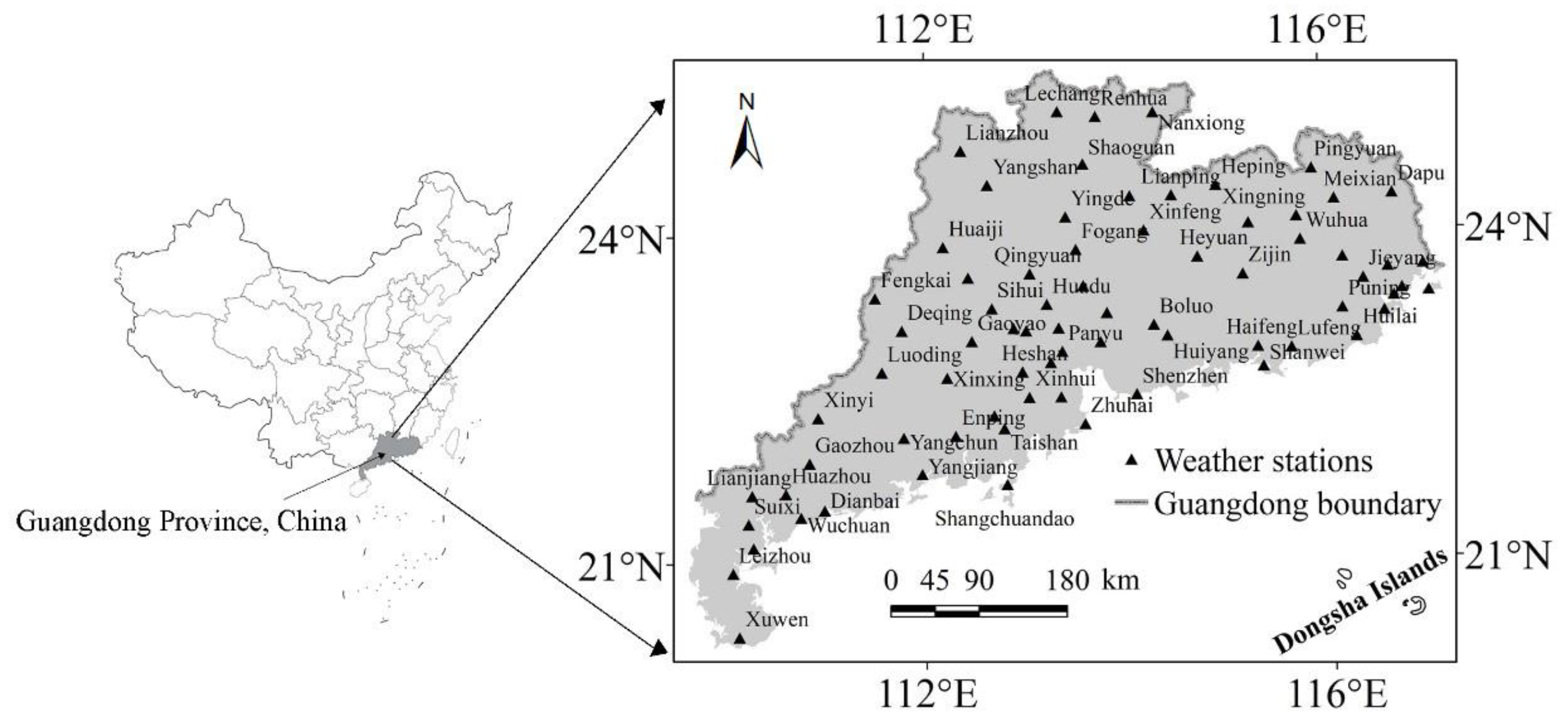
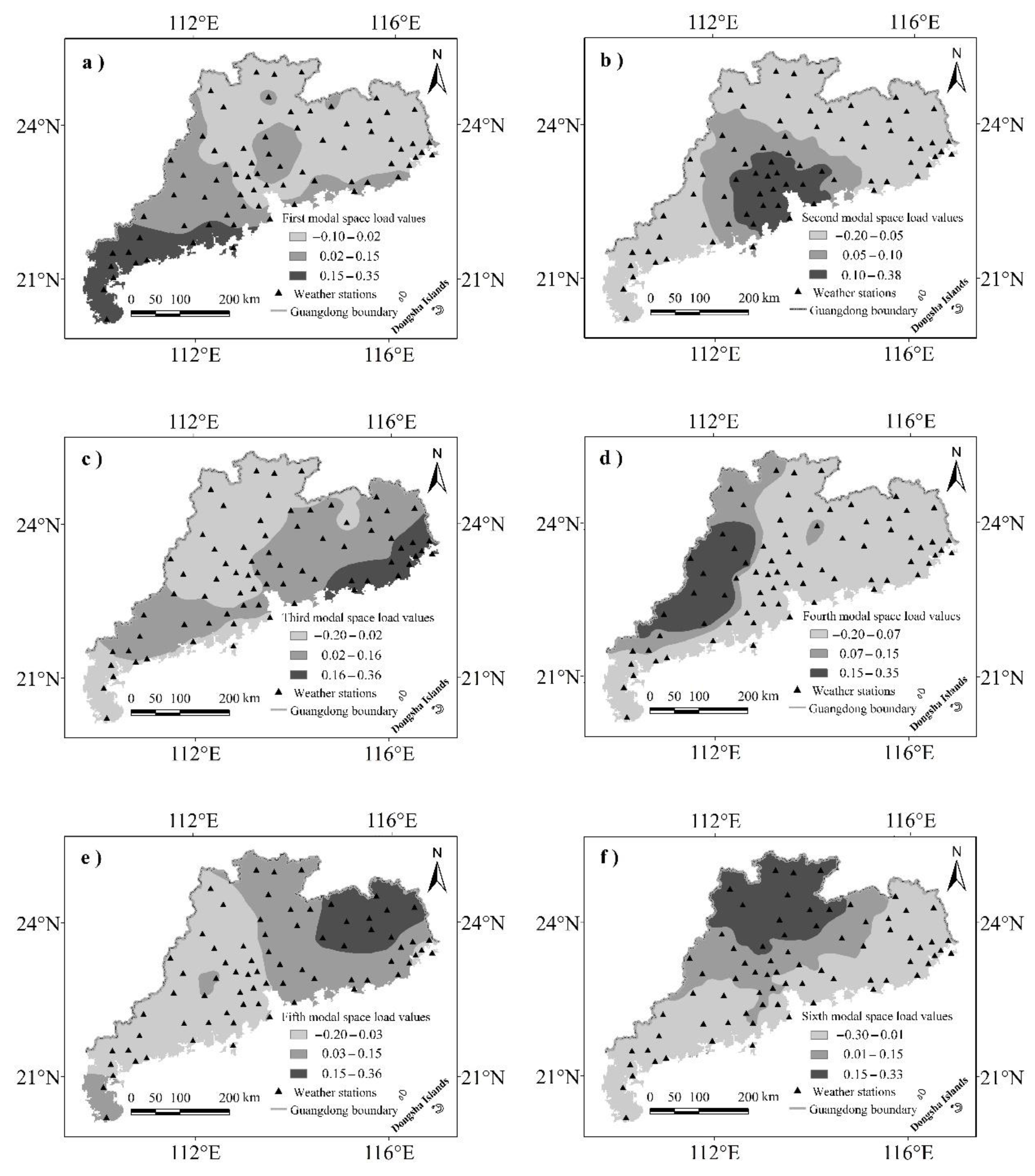

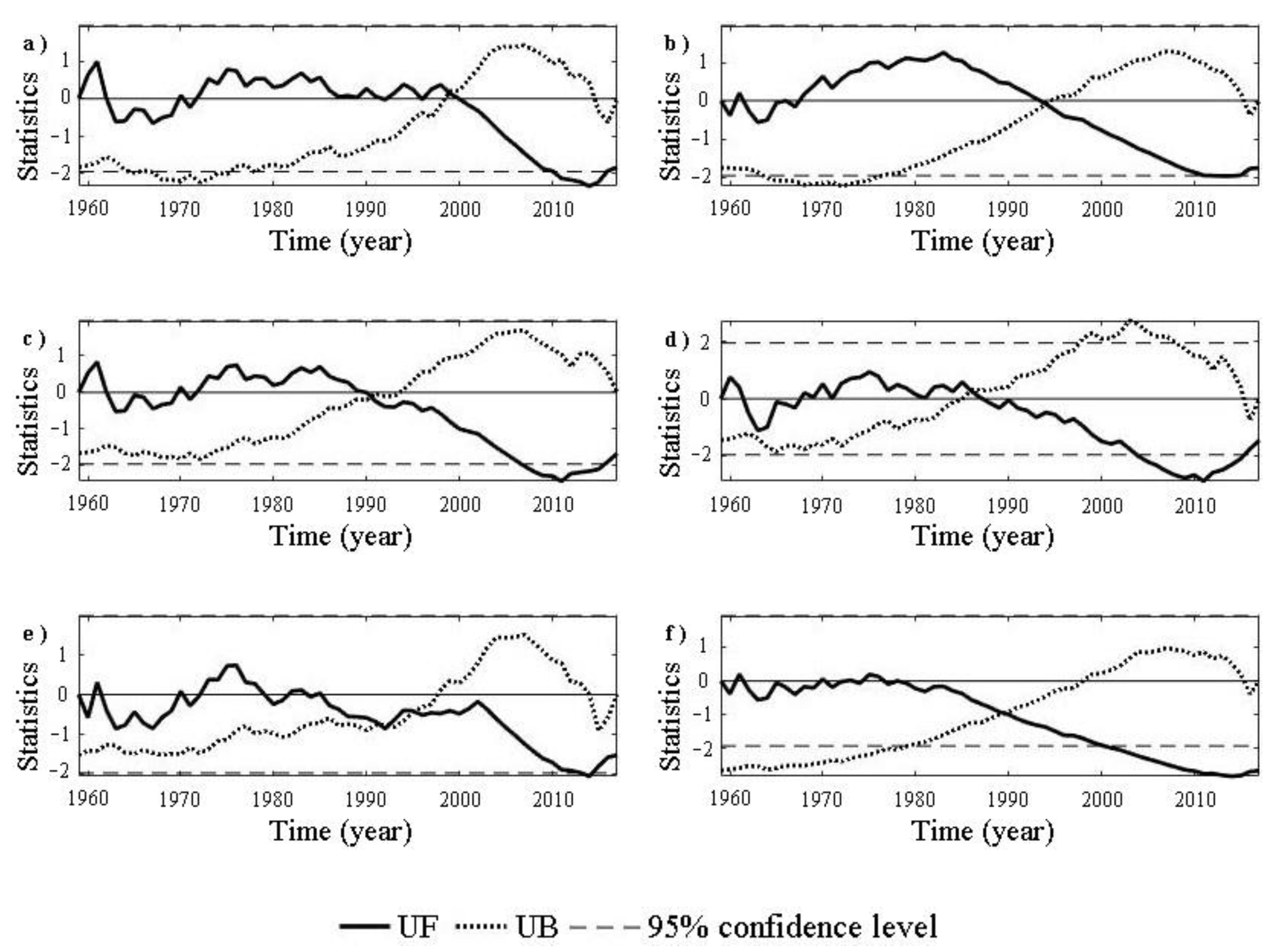
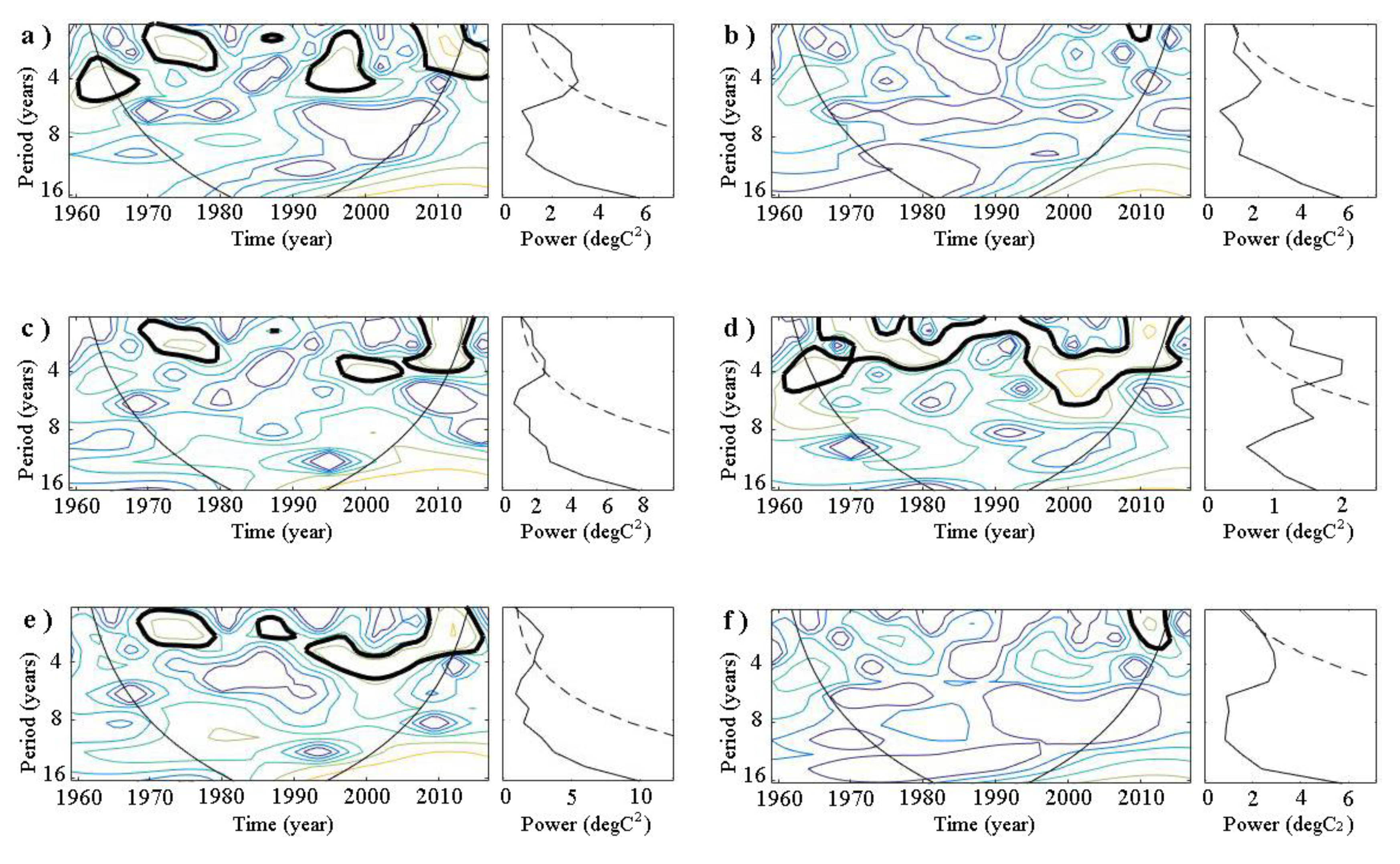
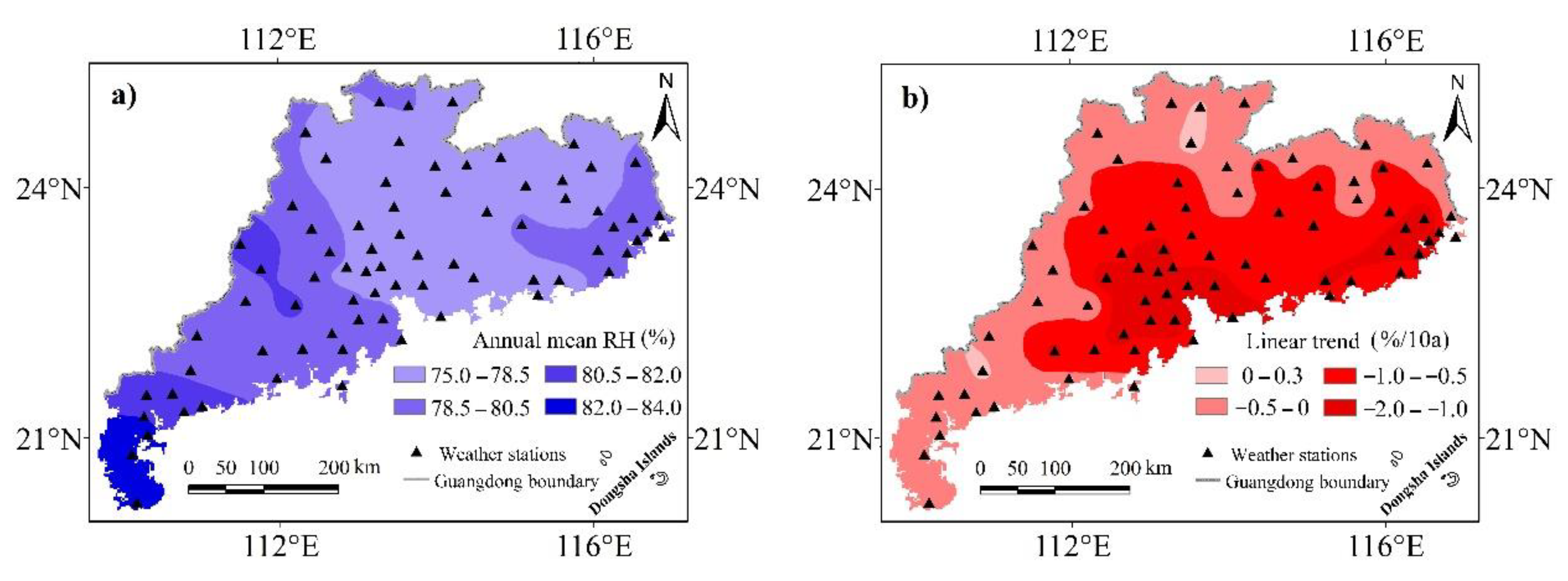
| Component | 1 | 2 | 3 | 4 | 5 | 6 |
|---|---|---|---|---|---|---|
| Variance contribution (%) | 22.8 | 20.7 | 16.4 | 15.1 | 13.6 | 6.5 |
| Cumulative variance contribution (%) | 22.8 | 43.5 | 59.9 | 75.1 | 88.7 | 95.2 |
| Subarea | Eastern Inland Subarea | Eastern Coastal Subarea | Western Inland Subarea | Western Coastal Subarea | Northern Inland Subarea | Pearl River Delta Subarea | The Whole Province |
|---|---|---|---|---|---|---|---|
| Annual mean (%) | 77.58 | 78.81 | 80.28 | 81.37 | 77.51 | 77.85 | 78.90 |
| Linear trend (%/10a) | −0.452 | −0.868 | −0.469 | −0.207 | −0.350 | −1.349 | −0.678 |
| M-K statistics | −2.91 | −4.57 | −3.13 | −1.92 | −2.71 | −6.73 | −4.42 |
| Subarea | Eastern Inland Subarea | Eastern Coastal Subarea | Western Inland Subarea | Western Coastal Subarea | Northern Inland Subarea | Pearl River Delta Subarea |
|---|---|---|---|---|---|---|
| Mutation time (year) | 1999 | 1994 | 1991 | 1986 | 1992 | 1990 |
| Significant period | 2010–2016 | 2011–2015 | 2007–2016 | 2004–2015 | 2013–2014 | 2000–2017 |
| Variation trend | decline | decline | decline | decline | decline | decline |
| Subarea | Significant Cycles (a) | Corresponding Periods | Subarea | Significant Cycles (a) | Corresponding Periods |
|---|---|---|---|---|---|
| Eastern inland subarea | 2∼3.5 | 1969–1979 | Eastern coastal subarea | 2.1∼2.3 | 2008–2011 |
| 2.3∼4.5 | 1992–2001 | ||||
| 2∼3.7 | 2007–2013 | ||||
| Western inland subarea | 2.1∼3.5 | 1969–1980 | Western coastal subarea | 2∼4 | 1964–2015 |
| 3.5∼4.5 | 1997–2004 | 4∼5.1 | 1996–2007 | ||
| 2∼4 | 2008–2015 | ||||
| Northern inland subarea | 2.1∼3.3 | 1968–1979 | Pearl River Delta subarea | 2∼3 | 2009–2014 |
| 2.3∼2.7 | 1985–1990 | ||||
| 2.7∼4.5 | 1992–2008 | ||||
| 2∼3.5 | 2008–2015 |
Publisher’s Note: MDPI stays neutral with regard to jurisdictional claims in published maps and institutional affiliations. |
© 2020 by the authors. Licensee MDPI, Basel, Switzerland. This article is an open access article distributed under the terms and conditions of the Creative Commons Attribution (CC BY) license (http://creativecommons.org/licenses/by/4.0/).
Share and Cite
Liu, Z.; Yang, H.; Wei, X. Spatiotemporal Variation in Relative Humidity in Guangdong, China, from 1959 to 2017. Water 2020, 12, 3576. https://doi.org/10.3390/w12123576
Liu Z, Yang H, Wei X. Spatiotemporal Variation in Relative Humidity in Guangdong, China, from 1959 to 2017. Water. 2020; 12(12):3576. https://doi.org/10.3390/w12123576
Chicago/Turabian StyleLiu, Zhanming, Hong Yang, and Xinghu Wei. 2020. "Spatiotemporal Variation in Relative Humidity in Guangdong, China, from 1959 to 2017" Water 12, no. 12: 3576. https://doi.org/10.3390/w12123576





